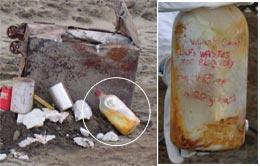 The glass bottle containing the plutonium (right) was found inside a rusty safe (left).Anal. Chem.
The glass bottle containing the plutonium (right) was found inside a rusty safe (left).Anal. Chem.The clean-up of a decommissioned US nuclear weapons plant has unearthed one of the oldest known samples of man-made plutonium.
Workers found roughly half a gram of weapons-grade plutonium-239 (Pu-239) in an abandoned safe at the Hanford Site in rural Washington state. Researchers at the nearby Pacific Northwest National Laboratory have dated the plutonium to roughly 1946, just two years after the United States tested its first nuclear device in the desert of New Mexico.
The sample is the second-oldest known man-made plutonium, according to Jon Schwantes, a research scientist at the laboratory and author on the paper, which appears online in the journal Analytical Chemistry1. The oldest sample, made in the early 1940s by Glen Seaborg of the University of California in Berkeley and his colleagues, is held by the Smithsonian in Washington.
Deadly trigger
Pu-239 is a staple of the world's nuclear arsenals. A few kilograms of the metal is all that is needed to make a fission device, and Pu-239 is commonly used in modern weapons as the 'primary', which triggers a more powerful secondary hydrogen blast.
But with a half-life of just 24,100 years, Pu-239 decays away too quickly to be found in nature. So in the 1940s, physicists had to learn how to make it themselves. They did so by burning uranium fuel in nuclear reactors, and chemically separating Pu-239 from the waste.
The contents of the bottle, found less than a mile from Schwantes' office, appear to be the final product of one of the earliest chemical separation processes. The half-gram of pure plutonium was dissolved in 400 millilitres of a lanthanum fluoride solution. That solution was the first clue, Schwantes says, because it hasn't been used in separation since the mid-1950s.
The second clue came from elemental makeup of the mix. For decades, the once pure plutonium in the bottle had been decaying back into uranium, and the ratio of uranium to plutonium gave an age of 61.6 ± 4.5 years. That made this plutonium among the earliest ever made, and meant that it had to have come from just a handful of reactors in the US.
Isotope trail
Giant reactors at the Hanford Site produced nearly all the plutonium used in the US nuclear arsenal, but the ratios of different plutonium isotopes pointed to a smaller reactor. Schwantes says that computer modeling showed a "near perfect match" with an experimental reactor near Oak Ridge, Tennessee, known as X-10. Historical documents showed that 96 "slugs" of X-10 fuel were sent to Hanford in 1944 before the site's large reactors were fully operational. The fuel was used to test new plutonium extraction techniques, and Schwantes now believes that this batch of plutonium was the upshot of those early tests.
Schwantes says that he believes that this "nuclear archeology" serves as an important example of how scientists can attribute small samples of nuclear material to a specific source. Such attribution could help reduce nuclear smuggling and nuclear terrorism because countries that produce the material will be held to account, he claims. "The countries originally responsible for this kind of material will feel responsible."
"What they are doing are very good measurements," says a scientist with the International Atomic Energy Agency in Vienna, who declined to be identified because of his ongoing work on nuclear safeguards. But, he adds, tracing modern nuclear material is a far trickier business.
Just 11 reactors were operating in the United States in 1950, and only four were being used for plutonium work. By contrast a modern sample could come from any one of hundreds of military and industrial reactors. In today's environment "you can narrow it down to several possible sources", the scientist says, "but you have no real proof."
Corrected:
The plutonium found at the Hanford site is the second oldest known sample, not the oldest as we stated in a previous version of this article. The piece has been corrected to reflect this.



No comments:
Post a Comment